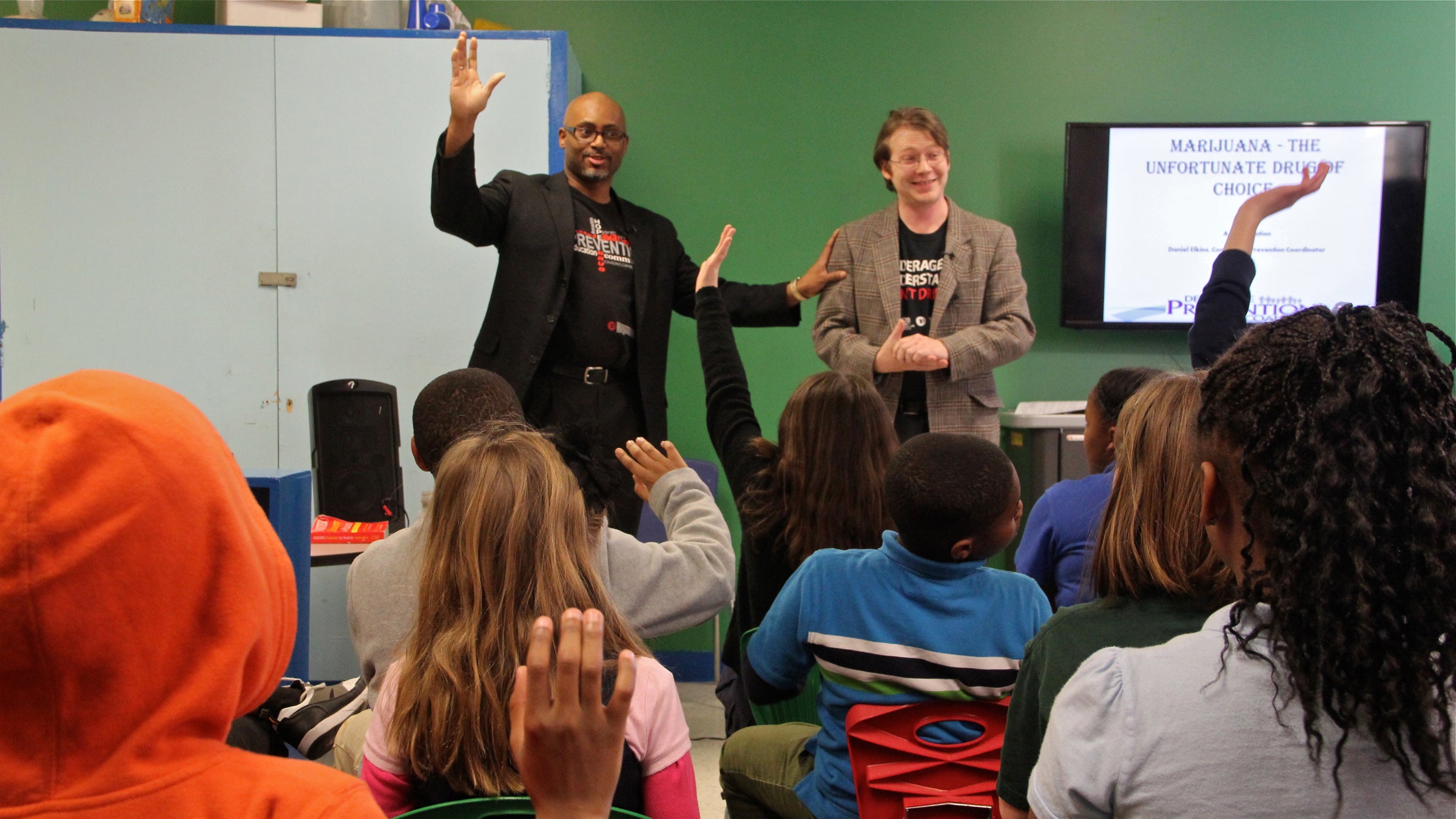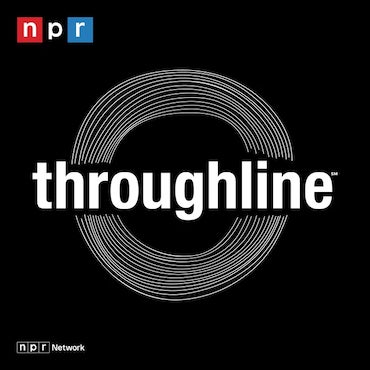What’s the best way to craft messages to kids about drugs?
Listen
Community prevention coordinators John Hampton (left) and Daniel Elkins present an anti-drug program to children at the Bellevue Community Center in Wilmington, Delaware. (Emma Lee/WHYY)
The science of public service announcements is tricky.
If someone offers you drugs, prevention educator John Hampton says, that’s the one time kids have permission to lie.
Say you need to pee. Tell them you can’t because you’ll get in trouble with your coach. Any excuse will do.
“You don’t have to be mad, you don’t have to ask ’em ‘what is it?'” Hampton said. “Tell ’em you’ll be right back and walk away.”
Hampton is a community educator in Delaware and travels the state talking to kids.
At Bellevue Community Center in Wilmington, his audience was a group of 9, 10 and 11 year olds. Hampton told them that taking drugs is like pulling from a deck of cards. An overdose is a king or queen.
“But if you get lucky and pull a couple of 2s, messing with drugs, what happens is, you start to think you are bulletproof and nothing is going to happen,” Hampton said. “That’s what gets people in trouble; they get lucky a couple times.”
It’s easy to slide into addiction, Hampton says, so he teaches the students 10 different ways to say ‘no’ the first time. Hampton plays the role of a friend, or a drug dealer, and the kids take turns practicing their refusal skills. Asaiah DeWitte, a fourth-grader in glasses and a pink and purple bracelet, came up with some of the most creative pushback for the peer pressure.
First, she blamed her parents—that’s number one on Hampton’s ‘ways to say no’ list.
“No, actually my mom just texted me and I have to go help her with my sister,” Asaiah said, during a role-playing exercise.
Then she says she has to be somewhere: “I have to go practice my dance routine.”
Tens of millions of state and federal drug-prevention dollars are invested in school and community programs like this one. The children practice decision making and are given basic information.
As an adult sitting in the back of the room, you might think John Hampton’s approach is preachy. You might think that kids who listen to hip hop artist Fetty Wap, would consider Hampton’s inspirational rap song a little corny:
“You need to understand you are miracles in the making and anyone who tells you otherwise are mistaken. You’re created for greatness. I refuse to be average”
But, the kids were excited and chimed in to sing.
Asaiah said she’s learning.
“Alcohol can make you dehydrated, because it’s a liquid,” she said. “I thought it would just, like, make you drunk.”
The Delaware Prevention Coalition organized the after-school assembly. Lisa Graham, statewide prevention coordinator, said the presentations are based on an evidence-based curriculum.
Changing up the approach
But even just a year from now, the 9- and 10-year-olds may be bored by these particular tactics.
Ask any fifth grader, and she’ll tell you smoking is bad. She probably already knows you can overdose on meth, said Kathleen Kelly, director of the Center for Marketing and Social Issues at Colorado State University.
Her team developed and tested a school and community substance abuse program “Be Under Your Own Influence,” funded by the National Institute on Drug Abuse.
As children get older, marketing experts say educators have to change up their approach.
The latest national Youth Anti-Drug Media Campaign, “Live Above the Influence,” doesn’t include a lot of drug facts or a long list of the awful things that can happen if you smoke or drink.
In one TV commercial, you see groups of teenagers at home or at a party. A big omnipotent hand sweeps in and nudges one of the kids to take a prescription bottle from the medicine cabinet, or in another scene, to sip beer from a red plastic cup. Each time that happens, one of the teens pushes back.
The campaign began in 2005, and the White House says youth exposed to those messages are less likely to start using marijuana.
Some prevention efforts don’t work, or worse, they can make kids more curious about drugs. From 1998 to 2004, the federal government spent about a billion dollars on an older campaign–called “The Anti-Drug” that some experts call a failure. Research suggests that the ads made drug use seem familiar and acceptable for certain teen populations.
The DARE program, Drug Abuse Resistance Education, has been used in thousands of schools across the country. But a 2009 review of 20 studies found that teen participants were just as likely to use drugs as teens who weren’t exposed to the program.
“Did it decrease drug use over time? No,” Kelly said.
Advertising executive Mike Sukle says when it comes to anti-drug and alcohol messages, adolescents and younger teens are more receptive than older teens who’ve already made up their mind about drugs.
For a recent campaign in Colorado, he said, “the sweet spot is that 12 to 15 year old.”
Sukle Advertising designed a marketing effort to steer teens away from weed in Colorado. But recreational marijuana is legal for adults in that state, which complicates the prevention message.
In Colorado, they decided to tell teens about studies that found that marijuana hurts developing brains. The “Don’t be a Lab Rat” campaign also fessed up that the research is preliminary–even the scientists don’t know for sure.
“And then it asks them, do you want to be a lab rat, do you want to be the generation that will prove or disprove this study, and leaves the decision up to them,” Sukle said.
The marketing team set up human-sized lab rat cages at a skatepark and a library in Denver, and waited for kids to get curious.
Reaching teens on social media—like Snapchat and Twitter—works, but Sukle says it’s almost more important to engage kids by giving them things to interact with and do.
The Colorado campaign used interactive movie ads—that asked kids to raise their hands in response to a series of questions: Are you a teenager? Have you smoked weed? Do you have IQ points to spare? The theater ad ends with a spooky reveal—a black screen arises, suggesting that scientists are watching and studying kids.
Don't Be a Lab Rat – IQ from Sukle Advertising & Design on Vimeo.
In Montana, an anti-meth campaign used scare tactics. The commercials show skinny meth users with rotting teeth, and include uncomfortable scenes of prostitution, domestic violence, burglary.
Kathleen Kelly–a professor of marketing at Colorado State University–says fear appeals work, but the results don’t last long. So around prom season, high schools stage dramatic demonstrations with crashed cars and bleeding, banged-up students to show what can happen if you drive under the influence.
“These kids file out of auditoriums and say: I’m never going to do that,” Kelly said.
Kelly’s expertise is social marketing.
“Instead of trying to sell you more hamburgers or lip gloss—or whatever, using those tools of marketing to try to un-sell behavior,” she explained.
Scare tactics work for drugs like meth, cocaine and heroin, but Kelly says fear appeals are pretty ineffective for more commonly used drugs such as marijuana.
What’s realistic?
Tim Rabolt, 23, says when he was in high school, students were told not to drink and drive – and his teachers made the “hard stuff” sound scary.
“That seemed terrifying to do, but everything else seemed perfectly OK, and then there was nothing about prescription pills, so that’s what took off in high school, everyone was using pills because it was prescribed by a doctor, so it must be OK. That was the thinking behind that,” said Rabolt, who is now a graduate student at George Washington University, where he works on college substance abuse efforts.
Rabolt remembers that kids would crush up study drugs to pull an all-nighter or lose weight. He’s clean and sober now, but Rabolt says he and lots of his high school classmates mixed medicine and alcohol to party on the weekends.
“I honestly think it’s just a waste of resources to try and get students and young kids to never try drugs. I just don’t think that’s realistic,” Rabolt said. But he said celebrities who’ve stumbled—and gotten back up—could be the best ambassadors to speak to teens about substance abuse.
More conversation, less preaching
“Everybody’s doing it,” Lisa Graham hears that from teenagers a lot.
She’s the statewide prevention coordinator for Delaware’s Prevention Coalition. Graham has no plans to stop asking kids to avoid drugs. But she says prevention messages have come a long way since First Lady Nancy Reagan told us all to: “Just Say No.”
“Now it has to be more of a conversation, you can’t just preach to the kids and tell them “No,” you have to be able to explain why I should do this and what happens if I do this,” she said.
Over the years, health researchers and social marketers have modified their message for different populations. The “Long Way Home” ad–from the Partnership for a Drug Free America–was designed for inner-city kids–and to fight the stereotype that poor kids are OK, with the drugs in their neighborhood. It’s tone is like a response ad to the DARE approach and Nancy Reagan’s edict—making it clear that those strategies aren’t working for everyone.
In the commercial, you see an elementary-age boy cutting through alleys and over fences after school: “My teacher tells us to: “Just say no,” policemen said the same thing. They don’t have to walk home through here, ’cause, the dealers are scared of police, but they’re not scared of me, and they don’t take ‘no’ for an answer.”
In 1994, that ad won the American Marketing Association’s “Grand EFFIE.” It was the firs time a PSA won that award.
Health researchers say it’s normal for teens to test limits and take moderate risks. They’re supposed to challenge what adults tell them to do.
So, given that, today’s anti-drug campaigns are built on young people’s desire for autonomy—and taps into their goals.
WHYY is your source for fact-based, in-depth journalism and information. As a nonprofit organization, we rely on financial support from readers like you. Please give today.



